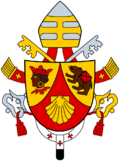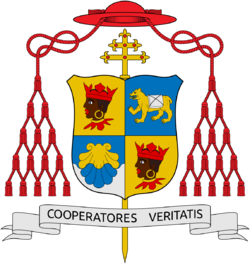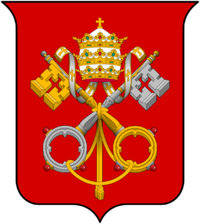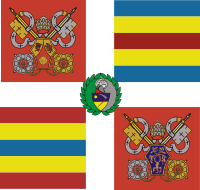Religion:Coat of arms of Pope Benedict XVI
| Coat of arms of Pope Benedict XVI | |
|---|---|
 | |
| Armiger | Benedict XVI |
| Adopted | 2005 |
The personal papal coat of arms of Pope Benedict XVI was designed by Archbishop Andrea Cordero Lanza di Montezemolo (who was later created a Cardinal) soon after the papal election in 2005.
History
The coat of arms was published in April 2005, after the papal election, in the Osservatore Romano.[1]
Shield
The shape of the shield varies from artist to artist. In the official rendering of the coat of arms of Pope Benedict XVI the shape chosen is that of a chalice.
Blazon
The blazon (the written description, in terminology peculiar to heraldry, of the contents of the coat of arms) given on the Vatican website is as follows:
This means, in non-technical English:
Note 1. A mantle outside the shield does not normally contain charges (an heraldic term for objects). Within the shield, as here, it is a religious symbol, and indicates ideals inspired in monastic spirituality.[citation needed] It is also a reference to the Order of Saint Benedict.
Charges
The charges of the arms — the Moor's head, Corbinian's bear, and scallop — appeared on Ratzinger's previous coat of arms, used when he was Archbishop of Munich and Freising. However, they relate not only to his origins, but also to his trust in God, as well his calling to spread this faith to others.
Scallop shell
The symbolism of the scallop shell is multiple. Saint Augustine is said to have been walking along the seashore, meditating on the unfathomable mystery of the Holy Trinity. A boy was using a shell to pour sea water into a little hole. When Augustine asked him what he was doing, he replied, "I am emptying the sea into this hole." Thus did Augustine understand that man would never penetrate to the depths of the mystery of God. While a doctoral candidate in 1953, Fr. Joseph Ratzinger wrote his dissertation on The People of God and the House of God in Augustine's Teaching is always about the Church, and the shell therefore has a personal connection with the thought of this great Doctor of the Church.
The scallop shell is also an allusion to the Sacrament of Holy Baptism. In the Roman Catholic Church, a sea shell is often used to pour water over the head of the child being baptized. Thus, a sea shell is used to evoke the imagery of this rite which is fundamental to the Christian life.
The shell also stands for pilgrimage. When topped with a scallop shell a pilgrim's staff, or "Jacob's staff", is the sign of a pilgrim. In Church art it is a symbol of the apostle Saint James the Great, and his sanctuary at Santiago de Compostela in Spain, perhaps the principal place of pilgrimage during the Middle Ages. This symbol also alludes to "the pilgrim people of God", a title for the Church which Joseph Ratzinger championed at the Second Vatican Council as peritus (theological adviser) to Cardinals Josef Frings of Cologne and Julius Döpfner of Munich-Freising (his episcopal predecessor). When he became Archbishop he took the shell in his coat of arms. It is also found in the insignia of the Schottenkloster in Regensburg, where the major seminary of that diocese is located, a place where Benedict taught as a professor of theology.
Finally, the pilgrimage symbolism of the shell may also refer both to the reconfigured role of the pope as not only ruler, but also pilgrim among the peoples and nations of the world. Pope Paul VI—who created Joseph Ratzinger as a cardinal in 1977—was often called the "Pilgrim Pope" for his ground-breaking travels to the Holy Land, India , the United States , Colombia, the Philippines , and elsewhere. This precedent was greatly elaborated upon by Pope John Paul II with his historic trips, numbering over a hundred. As a result, Benedict may be paying homage to these men and the new role for the papacy.
Moor of Freising
The Moor's head is a heraldic charge associated with Wörth, Upper Bavaria, Germany . The origin of the Moor's head in Freising is not entirely known. It typically faces to the heraldic right, the viewer's left (dexter in heraldic terms) and is depicted in natural brown colour caput Aethiopum (literally "Ethiopian head") with red lips, crown and collar. This is the ancient emblem of the Diocese of Freising, founded in the 8th century, which became a metropolitan archdiocese with the name of München und Freising in 1818, subsequent to the Concordat between Pius VII and King Maximilian Joseph of Bavaria (5 June 1817).
The Moor's head is fairly common in European heraldry. It still appears today in the arms of Sardinia and Corsica, as well as in the blazons of various noble families. Italian heraldry, however, usually depicts the Moor wearing a white band around his head instead of a crown, indicating a slave who has been freed; whereas in German heraldry the Moor is shown wearing a crown. The Moor's head is common in the Bavarian tradition and is known as the caput Ethiopicum or the Moor of Freising.[2]
Corbinian's bear
A legend states that while traveling to Rome, Saint Corbinian's pack horse was killed by a bear. He commanded the bear to carry the load. Once he arrived, he released it from his service, and it returned to Bavaria. The implication is that "Christianity tamed and domesticated the ferocity of paganism and thus laid the foundations for a great civilization in the Duchy of Bavaria."[3] At the same time, Corbinian's bear, as God's beast of burden, symbolizes the weight of office that Benedict carried.
External ornaments
Traditionally, a pope's coat of arms was externally adorned only by the three-tiered papal tiara with lappets and the crossed keys of Saint Peter with a cord. No other objects nor a motto was added. The tiara represented the roles of authority of the pope, while the keys represent the power to loose and bind on heaven and earth (Matt 16:19). Pope Benedict's arms maintain the keys, but replace the tiara with a mitre and add a pallium. However, the tiara and keys remain the symbol of the papacy, and appear on the coat of arms of the Holy See and (reversed) on the flag of Vatican City.
Mitre
In Pope Benedict's arms, the tiara is replaced with a silver mitre with three gold stripes.[4] These stripes recall the three crowns of the tiara, which came to represent the three powers of the Bishop of Rome: Orders, Jurisdiction and Magisterium. The stripes preserve that meaning and are joined at the centre to show their unity in the same person.
Pallium
The pallium with red crosses is also a new addition.[4] It represents a bishop's role of being pastor of the flock entrusted to him by Christ. The form of the pallium included in the coat of arms recalls that used by metropolitan archbishops (but with black crosses) rather than the much larger pallium worn by Pope Benedict at his inauguration.
After papal abdication
After Benedict resigned as pope in 2013 and assumed the role of pope emeritus, Cardinal Andrea Cordero Lanza di Montezemolo, who designed the coat of arms in 2005, said that Benedict XVI needed a new coat of arms now that he was no longer the pontiff. Montezemolo drew up a proposal for a new coat of arms (which was not officially adopted), which Montezemolo believed could be used now by the former pontiff. Montezemolo's proposal moved the big keys of Saint Peter from the back of the coat of arms to the top part of the shield and made them much smaller.[5]
References
- ↑ "L'Osservatore Romano publishes new Papal coat of arms" (in en). 27 April 2005. https://www.catholicnewsagency.com/news/3766/losservatore-romano-publishes-new-papal-coat-of-arms.
- ↑ "Coat of Arms of His Holiness Benedict XVI". Vatican Publishing House. Archived from the original on 2020-02-26. https://web.archive.org/web/20200226173537/http://www.vatican.va/content/benedict-xvi/en/elezione/documents/stemma-benedict-xvi.html. Retrieved 2020-09-12.
- ↑ "The bear and the scallop-shell — a unique papal coat of arms". Catholic World News. 27 April 2005. http://www.cwnews.com/news/viewstory.cfm?recnum=36801. Retrieved 5 January 2007.
- ↑ 4.0 4.1 Glatz, Carol (2005-05-18). "Pope drops papal crown from coat of arms, adds miter, pallium". Catholic News Service. http://www.catholicnews.com/data/stories/cns/0502625.htm. Retrieved 2012-03-23.
- ↑ Estefania Aguirre (May 4, 2013). "Benedict XVI needs new coat of arms, designer says". http://www.catholicnewsagency.com/news/benedict-xvi-needs-new-coat-of-arms-designer-says/.
External links
- "The Coat of Arms of His Holiness Benedict XVI". Libreria Editrice Vaticana. http://www.vatican.va/content/benedict-xvi/en/elezione/documents/stemma-benedict-xvi.html.





